In our previous blog post we had discussed about What is Data Masking in Salesforce. In these blog post we discuss about How to get Today Date in Salesforce Formula
Contents
- 1 How to get Today Date in Salesforce Formula
- 1.1 What are Date Functions in Salesforce?
- 1.2 Syntax and Usage of Date Functions
- 1.3 Creation process of today date field:
- 1.4 Benefits of Using Date Functions in Salesforce Formulas
- 1.5 Getting Today’s Date Automatically in Salesforce Formulas
- 1.6 Leveraging Custom Date Fields for Dynamic Sales Tracking
- 1.7 Real-World Applications of Today’s Date in Salesforce Formulas
- 1.8 Enhancing Salesforce Formulas with Dynamic Date Calculations
- 1.9 Implementing Conditional Date Logic in Salesforce Formulas
- 1.10 Optimizing Sales Dashboard with Real-Time Date Updates
- 1.11 Summary:
- 1.12 FAQs:
How to get Today Date in Salesforce Formula
What are Date Functions in Salesforce?
Date functions in Salesforce are powerful tools that allow users to manipulate and work with date values within formulas. These functions serve a crucial role in enhancing sales tracking by providing the ability to perform calculations and operations based on dates.
- Definition and Purpose of Date Functions
Date functions enable users to perform a wide range of operations such as adding or subtracting days, months, or years to a given date. These functions help automate date-related processes and ensure accurate tracking of sales activities.
- Common Date Functions Used in Salesforce Formulas
Some commonly used date functions in Salesforce include:
- TODAY(): Retrieves the current date.
- DATE(): Creates a date value based on specified year, month, and day.
- DAY(), MONTH(), YEAR(): Extracts the day, month, and year from a date value.
- How Date Functions Enhance Sales Tracking
Date functions play a vital role in sales tracking by allowing for dynamic date calculations, conditional date logic, and real-time updates in Salesforce formulas.
Syntax and Usage of Date Functions
“Mastering the syntax of date functions is key to unlocking their full potential in Salesforce formulas.”
- Basic Syntax of Date Functions in Salesforce Formulas
Date functions in Salesforce follow a specific syntax, such as FUNCTION_NAME(parameters). Understanding this syntax is essential for effectively using date functions in formulas.
- Examples of Date Functions in Practical Salesforce Scenarios
For instance, using the TODAY() function in a formula can automatically capture the current date when a sales rep updates a record. This feature streamlines the sales workflow and ensures accurate time-stamping of sales activities.
- Best Practices for Implementing Date Functions
Ensure to document the usage of date functions in Salesforce formulas for future reference. Additionally, regularly review and optimize date functions to maintain data accuracy and efficiency in sales tracking.
Creation process of today date field:
To create a formula field on the Account object that displays the current date, follow these steps:
- Navigate to the Account Object:
Go to the Account object in Salesforce.
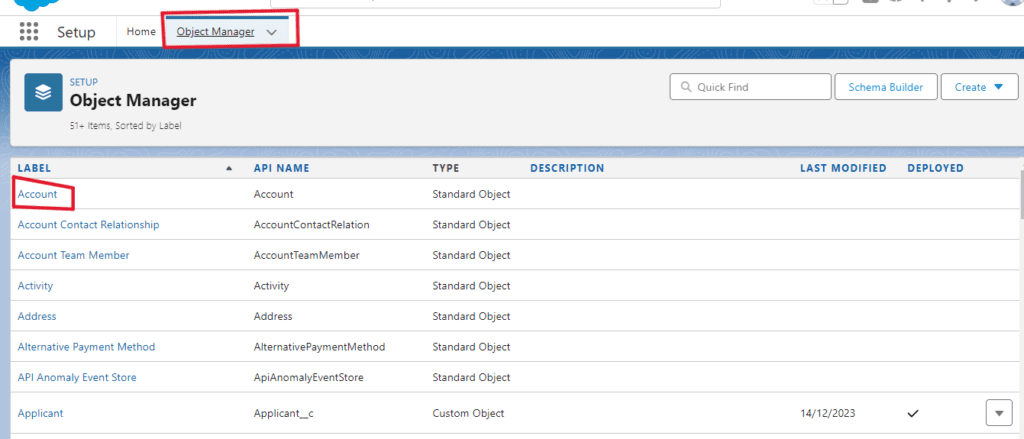
Click on the “New” button to create a new field.

- Choose the Field Type:
Select “Formula” as the field type.
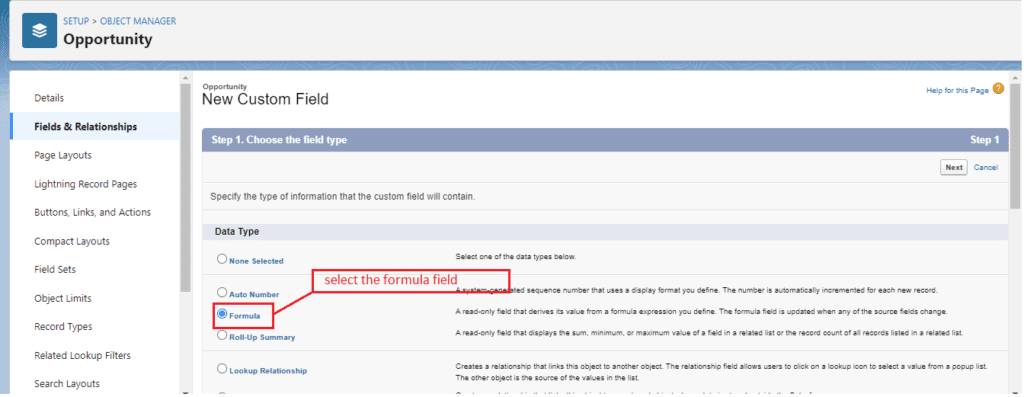
- Enter the Formula:
In the formula editor, enter the following syntax: TODAY()
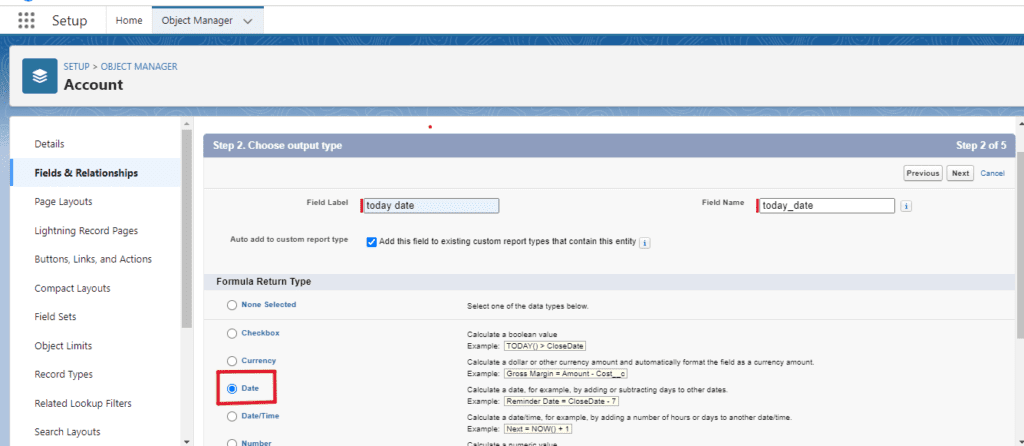
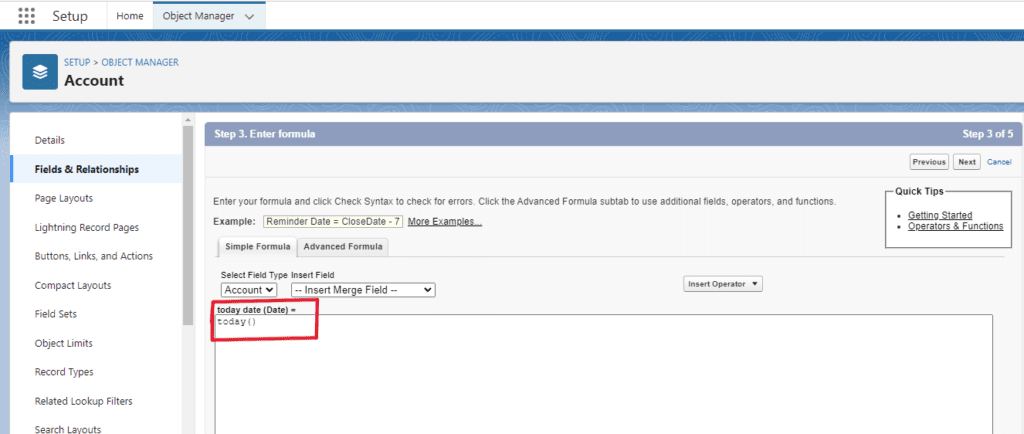
This will display the current date without any time component.
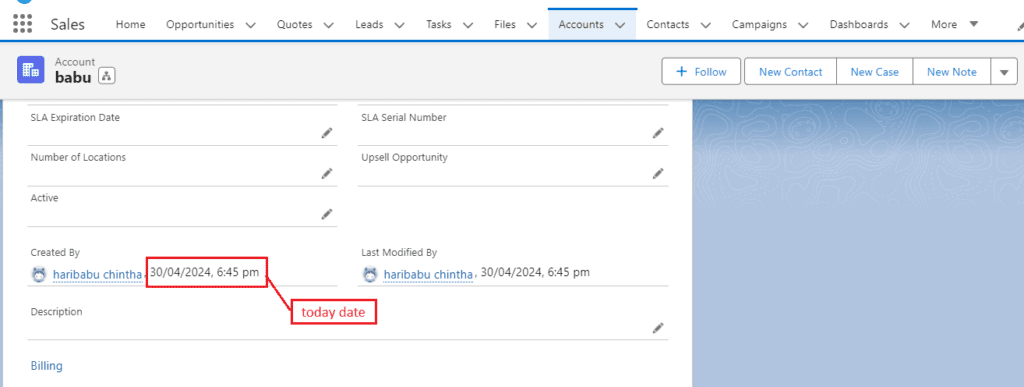
- Save the Formula Field:
Click on the “Save” button to save the formula field.
- View the Formula Field:
Once the formula field is saved, you can view the current date on the Account record.
By following these steps, you can create a formula field on the Account object that displays the current date using the TODAY() function.
Benefits of Using Date Functions in Salesforce Formulas
- Improved Accuracy in Recording Sales Activities
Date functions help in recording sales activities accurately by automatically capturing relevant date information without manual intervention.
- Streamlined Workflow for Sales Teams
Automating date-related processes using Salesforce formulas increases operational efficiency for sales teams, allowing them to focus more on closing deals.
- Enhanced Reporting Capabilities for Sales Analytics
By leveraging date functions in Salesforce formulas, businesses can generate customized sales reports and analytics to gain valuable insights for strategic decision-making.
You want know more about this topic is How to get Today Date in Salesforce Formula click here
Getting Today’s Date Automatically in Salesforce Formulas
Using TODAY() Function in Salesforce Formulas
“Harness the power of the TODAY() function to stay up-to-date with your sales tracking efforts.”
- Explanation of TODAY() Function
The TODAY() function retrieves the current date from the system and can be used to automatically capture the date in Salesforce formulas.
- Implementation of TODAY() Function in Salesforce Formulas
Integrating the TODAY() function in formulas ensures that the current date is always reflected in sales records, providing real-time insights into sales activities.
- Advantages of Automatically Capturing Today’s Date
By automatically capturing today’s date in Salesforce formulas, organizations can ensure up-to-date sales tracking and eliminate manual date entries.
Leveraging Custom Date Fields for Dynamic Sales Tracking
- Creating Custom Date Fields in Salesforce
Custom date fields can be created in Salesforce to capture specific date-related information tailored to the business’s sales processes.
- Linking Custom Date Fields with TODAY() Function
Linking custom date fields with the TODAY() function enables dynamic sales tracking based on custom date criteria, facilitating accurate sales reporting.
- Customizing Date Fields for Specific Sales Processes
Tailoring custom date fields to match unique sales processes enhances the granularity of sales tracking and enables targeted analysis of sales data.
Real-World Applications of Today’s Date in Salesforce Formulas
- Case Studies of Successful Sales Tracking with TODAY() Function
Businesses that have effectively utilized the TODAY() function in Salesforce formulas have experienced improved sales tracking accuracy and efficiency.
- Tips for Integrating Today’s Date in Complex Formulas
When working with complex sales formulas, ensure to implement today’s date functionality strategically to avoid formula errors and inconsistencies.
- Potential Challenges and Solutions for Using Today’s Date Effectively
Addressing challenges such as timezone variations and date format discrepancies can help in leveraging today’s date effectively across different Salesforce environments.
Enhancing Salesforce Formulas with Dynamic Date Calculations
Calculating Future or Past Dates in Salesforce Formulas
- Using Date Functions for Forward-looking Sales Projections
Date functions enable businesses to project future sales trends based on historical data and calculate future dates for sales activities.
- Calculating Historical Data Based on Date Functions
By utilizing date functions in Salesforce formulas, businesses can analyze historical sales data based on specific date ranges and criteria.
- Strategies for Dynamic Date Calculations in Salesforce
Implementing dynamic date calculations in Salesforce requires a strategic approach to ensure accurate and meaningful insights for sales tracking.
Implementing Conditional Date Logic in Salesforce Formulas
- Setting Criteria for Date-based Triggers in Salesforce Formulas
Conditional date logic allows for setting specific criteria based on dates to trigger automated sales processes or alerts in the Salesforce system.
- Automating Sales Processes with Dynamic Date Logic
By automating date-based triggers, sales teams can streamline repetitive tasks and focus on more strategic sales activities.
- Customizing Conditional Date Logic for Different Sales Scenarios
Tailoring conditional date logic based on unique sales scenarios enhances the flexibility and adaptability of Salesforce formulas for diverse business needs.
Optimizing Sales Dashboard with Real-Time Date Updates
- Integrating Today’s Date with Sales Dashboards for Live Updates
Real-time date updates on sales dashboards provide immediate insights into current sales performance and trends for informed decision-making.
- Monitoring Sales Performance with Dynamic Date Calculations
By monitoring sales performance with dynamic date calculations, businesses can track progress and adapt sales strategies in real-time.
- Enhancing Decision-making with Real-Time Date Insights
Accurate and real-time date insights empower businesses to make data-driven decisions and capitalize on sales opportunities effectively.
In today’s dynamic sales environment, mastering date functions in Salesforce formulas is essential for efficient sales tracking and insightful sales analytics. By leveraging the power of date functions, businesses can streamline sales processes, enhance reporting capabilities, and optimize sales performance for sustainable growth and success.
Remember, when it comes to Salesforce formulas, staying up-to-date with today’s date is the key to unlocking a world of possibilities for efficient sales tracking and dynamic sales calculations. So, embrace the power of date functions and elevate your sales tracking efforts to new heights!
Summary:
In this comprehensive guide, we have explored the key aspects of utilizing today’s date in Salesforce formulas for efficient sales tracking. Understanding date functions, capturing today’s date automatically, and enhancing formula calculations with dynamic date logic are essential for optimizing sales processes in Salesforce. By implementing these strategies and best practices, sales teams can improve accuracy, streamline workflow, and enhance reporting capabilities for effective sales analytics.
FAQs:
- Can I use today’s date in Salesforce reports?
Yes, you can incorporate today’s date in Salesforce reports by utilizing date functions in report filters or creating custom date fields linked to the TODAY() function.
- How do I calculate future dates in Salesforce formulas?
To calculate future dates in Salesforce formulas, you can use date functions such as DATE(), DATETIME(), and ADDMONTHS() to perform dynamic date calculations based on specific criteria.
- What are the benefits of automating date updates in Salesforce formulas?
Automating date updates in Salesforce formulas ensures real-time accuracy in sales tracking, minimizes manual data entry errors, and improves overall efficiency in sales processes.
In next blog we will discuss about How to get Business hours in Salesforce

2 thoughts on “How to get Today Date in Salesforce Formula”